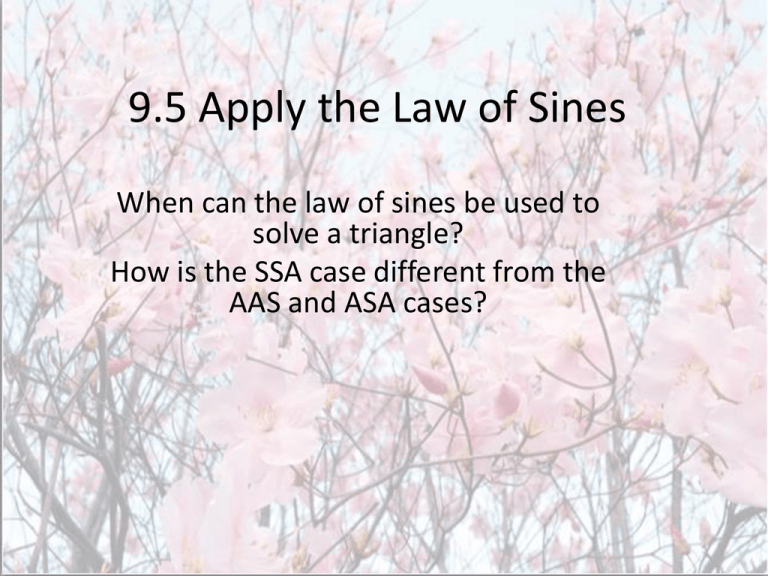sin
advertisement

9.5 Apply the Law of Sines When can the law of sines be used to solve a triangle? How is the SSA case different from the AAS and ASA cases? Law of Sines The law of sines can be used to solve triangles when two angles and the length of any side are known. (AAS or ASA cases), or when the lengths of two sides and an angle opposite one of the two side are known (SSA case). Solve ABC with C = 107°, B = 25°, and b = 15. SOLUTION First find the angle: A = 180° – 107° – 25° = 48°. By the law of sines, you can write a 15 c = = sin 48° sin 25° sin 107° a 15 Write two equations, = sin 48° sin 25° each with one variable. c 15 = sin 107° sin 25° 15 sin 48° 15 sin 107° Solve for each variable. c = a = sin 25° sin 25° a 26.4 ANSWER In Use a calculator. ABC, A = 48°, a c 33.9 26.4, and c 33.9. Solve ABC. SOLUTION 1. B = 34°, C = 100°, b = 8 First find the angle: A = 180° – 34° – 100° = 46°. By the law of sines, you can write a 8 c = = sin 46° sin 34° sin 100° a 8 c 8 Write two equations, each = = sin 46° sin 34° with one variable. sin 100° sin 34° 8 sin 46° a = sin 34° a 8 sin 100° Solve for each variable. c = sin 34° 10.3 c 14.1 Use a calculator. ANSWER In ABC, A 46°, a 10.3, and c 14.1. Solve ABC. 2. A = 51°, B = 44°, c = 11 SOLUTION First find the angle: C = 180° – 51° – 44° = 85°. By the law of sines, you can write a b 11 = = sin 51° sin 44° sin 85° a 11 Write two equations, each b 11 = = sin 51° sin 85° with one variable. sin 44° sin 85° 11 sin 51° 11 sin 44° a = sin 85° Solve for each variable. b = sin 85° a 8.6 ANSWER In Use a calculator. ABC, A 85°, a b 7.7 8.6, and b 7.7. SSA Case Two angles and one side (AAS or ASA) determine exactly one triangle. Two sides and an angle opposite one of the sides (SSA) may determine: • no triangle • one triangle • two triangles. Solve ABC with A = 115°, a = 20, and b = 11. SOLUTION First make a sketch. Because A is obtuse and the side opposite A is longer than the given adjacent side, you know that only one triangle can be formed. Use the law of sines to find B. sin B sin 115° = 20 11 11 sin 115° sin B = 20 B = 29.9° Law of sines 0.4985 Multiply each side by 11. Use inverse sine function. You then know that C 180° – 115° – 29.9° = 35.1°. Use the law of sines again to find the remaining side length c of the triangle. c sin 35.1° = 20 Law of sines sin 115° 20 sin 35.1° c = sin 115° Multiply each side by sin 35.1°. c 12.7 Use a calculator. ANSWER In ABC, B 29.9°, C 35.1°, and c 12.7. This is a SSA case with one solution. Solve ABC with A = 51°, a = 3.5, and b = 5. SOLUTION Begin by drawing a horizontal line. On one end form a 51° angle (A) and draw a segment 5 units long (AC , or b). At vertex C, draw a segment 3.5 units long (a). You can see that a needs to be at least 5 sin 51° 3.9 units long to reach the horizontal side and form a triangle. So, it is not possible to draw the indicated triangle. SSA case with no solution Solve ABC with A = 40°, a = 13, and b = 16. SOLUTION First make a sketch. Because b sin A = 16 sin 40° 10.3, and 10.3 < 13 < 16 (h < a < b), two triangles can be formed. Triangle 1 Triangle 2 See Example 4, page 588 Use the law of sines to find the possible measures of B. sin B sin 40° = 16 13 16 sin 40° sin B = 13 Law of sines 0.7911 Use a calculator. There are two angles B between 0° and 180° for which sin B 0.7911. One is acute and the other is obtuse. Use your calculator to find the acute angle: sin–1 0.7911 52.3°. The obtuse angle has 52.3° as a reference angle, so its measure is 180° – 52.3° = 127.7°. Therefore, B 52.3° or B 127.7°. Now find the remaining angle C and side length c for each triangle. Triangle 1 C Triangle 2 180° – 40° – 52.3° = 87.7° C 13 c = sin 40° sin 87.7° 13 sin 87.7° c = sin 40° ANSWER 180° – 40° – 127.7° = 12.3° 13 c = sin 40° sin 12.3° 20.2 c = 13 sin 12.3° sin 40° 4.3 ANSWER In Triangle 1, B 52.3°, C 87.7°, and c 20.2. In Triangle 2, B 127.7°, C 12.3°, and c 4.3. SSA case with two solutions Solve ABC. 3. A = 122°, a = 18, b = 12 SOLUTION sin B sin 122° = Law of sines 18 12 12 sin 122° 0.5653 Multiply each side by 12. sin B = 18 Use inverse sine function. B = 34.4° You then know that C 180° – 122° – 34.4° = 23.6°. Use the law of sines again to find the remaining side length c of the triangle. c 18 Law of sines sin 23.6° = sin 122° 18 sin 23.6° c = sin 122° Multiply each side by sin 23.6°. Use a calculator. c 8.5 ANSWER In ABC, B 34.4°, C 23.6°, and c 8.5. Solve ABC. 4. A = 36°, a = 9, b = 12 SOLUTION Because b sin A = 12 sin 36° ≈ 7.1, and 7.1 < 9 < 13 (h < a < b), two triangles can be formed. Use the law of sines to find the possible measures of B. sin B sin 36° = Law of sines 12 9 12 sin 36° 0.7837 Use a calculator. sin B = 9 There are two angles B between 0° and 180° for which sin B 0.7831. One is acute and the other is obtuse. Use your calculator to find the acute angle: sin–1 0.7831 51.6°. The obtuse angle has 51.6° as a reference angle, so its measure is 180° – 51.6° = 128.4°. Therefore, B 51.6° or B 128.4°. Now find the remaining angle C and side length c for each triangle. Triangle 1 C Triangle 2 180° – 36° – 51.6° = 92.4° C 9 c = sin 36° sin 92.4° 9 sin 92.4° c = sin 36° ANSWER In Triangle 1, B 51.6°, C 82.4°, and c 15.3. 180° – 36° – 128.4° = 15.6° 9 c = sin 36° sin 15.6° 15.3 c = 9 sin 15.6° sin 36° 4 ANSWER In Triangle 2, B 128.4°, C 15.6°, and c 4. Solve ABC. 5. A = 50°, a = 2.8, b = 4 2.8 ? b · sin A 2.8 ? 4 · sin 50° 2.8 < 3.06 ANSWER Since a is less than 3.06, based on the law of sines, these values do not create a triangle. ABC. Solve 6. A = 105°, b = 13, a = 6 SOLUTION sin A sin 105° = Law of sines 13 6 6 sin 105° 0.4458 Multiply each side by 6. sin A = 13 Use inverse sine function. A = 26.5° You then know that C 180° – 105° – 26.5° = 48.5°. Use the law of sines again to find the remaining side length c of the triangle. c 13 = Law of sines sin 48.5° sin 105° 13 sin 48.5° c = sin 105° Multiply each side by sin 48.5°. c ANSWER 10.1 Use a calculator. In ABC, A 26.5°, C 48.5°, and c 10.1. When can the law of sines be used to solve a triangle? • The law of sines says that in any triangle ABC, sin 𝐴 sin 𝐵 𝑠𝑖𝑛 𝐶 = = . 𝑎 𝑏 𝑐 • The law of sines is used to solve triangles with no right angle in the AAS, ASA and SSA cases. How is the SSA case different from the AAS and ASA cases? • In the SSA case, there may be one triangle, two triangles, or no triangles with the given measurements. 9.5 Assignment, day 1 Page 590, 3-25 odd No work is the same as a missing problem








